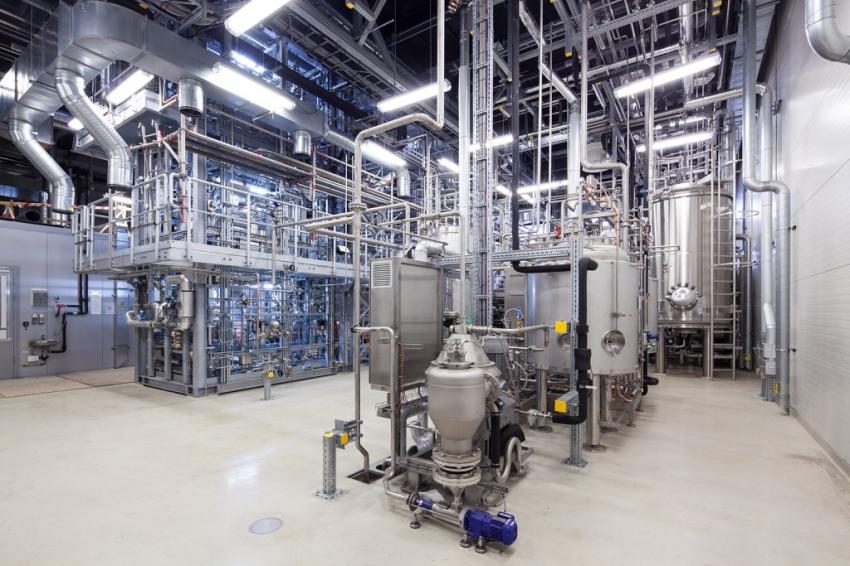Renewable Resources Into Isobutene
Unique Demonstration Plant for the Direct Fermentation of Gaseous Hydrocarbons Starts Operations
In November 2016 Global Bioenergies (GBE) completed the construction of the only demo plant in the world that is dedicated to the direct fermentation of gaseous hydrocarbons. It is located in the facility owned by the Fraunhofer CBP, on the Leuna refinery platform. It was financed in part by the German Federal Ministry of Education and Research (BMBF) through a grant of €5.7 million, and also through a €4.4 million loan obtained from a consortium of French banks (Société Générale, BNP-Paribas, CM-CIC and BPI). Dr. Birgit Megges asked Dr. Ales Bulc, CEO of Global Bioenergies’ German subsidiary, about details of the new plant.
Dr. Bulc, what have been the reasons for the development and construction of the demo plant?
Dr. A. Bulc: GBE has developed the genetically modified bacteria capable of converting sugars into light olefins. Most scientists, upon making an innovation/discovery which has been patented, wait for outside players to recognize the value of the invention and to make the discovery useful or profitable. GBE has taken a different approach. After securing the family of patents for the fermentative production of isobutene, GBE embarked on the path of developing the technological process and of commercializing the technology to the point where licenses for the process may be sold to interested inventors. This commercialization process needs a few milestones that must be achieved in order to succeed:
- GBE has decided to build a pilot plant that would prove the scale-up of the bacteria and a successful transfer of the bacteria from the laboratory into the industrial environment. A pilot plant was built at Pomacle in France and the bacteria were successfully transferred from liter scale fermenters in the Evry laboratory to a 500 liter fermenter in 2014. This proved the scalability of the bacteria and their transferability to industrial environment.
- However, to commercialize the technology, the process must first be engineered and the demonstration plant is typically used to demonstrate the availability and reliability of suitable equipment. GBE has identified the key components of the process from fermentation, purification and the support systems like media sterilization and broth inactivation, i.e. the complete process from feedstock (sugars) to the high purity product (isobutene) and treatment of waste (inactivation and wastewater treatment). Therefore, reputable industrial suppliers of functional units have been identified to secure the serviceability and maintainability of the equipment and automation system. In effect, available commercial equipment was identified, scaled down to the appropriate size and built in Leuna as the GBE demonstration plant.
- The Demonstration plant has the task to demonstrate the suitability and reliability of 24/7 operation of the plant and to provide data to validate the technological process as well as to provide key economic data for the production scale-up to the commercial plant.
What is the capacity of the demo plant?
Dr. A. Bulc: The size of the demonstration plant in Leuna was selected by the following criteria:
- The industry is using a scaling rule where the scale-up of with a factor of 100 is acceptable. The commercial plant would consist of several fermenters of sizes up to 500 cubic meters working in parallel. Therefore, the Demonstration plant production fermenter was selected at 5 cubic meters, with the seed fermenter at 500 liters to allow the direct comparison with the operations data obtained at the pilot plant in Pomacle.
- The demonstration plant must be large enough to produce samples that are not only suited for the analysis in the R&D departments of chemical producers and other interested parties but to allow the sample production runs at the existing plant using isobutene. Therefore, the demonstration plant needs to be capable of producing ton scale samples.
- With the above two main criteria, the demonstration plant was sized for nominal capacity to produce up to 100 tons of isobutene per year.
Why did you opt for the Leuna site and why did you choose a German location at all?
Dr. A. Bulc: GBE has looked all over the world for the suitable location for the Demonstration plant. Some locations in the US were identified as possible. However, when GBE learned about the Fraunhofer CBP facility the selection was made rather fast due to several reasons:
- Fraunhofer CBP had a permit to work with the genetically modified bacteria. While it would be easier to obtain such a permit in the USA, for example, it would still take some time while at CBP we could skip the GMO permitting process. As no investment/construction would be committed without the GMO permit, we saved time at CBP.
- CBP is part of the German Leading-Edge Clusters initiative and the location is specifically designed for the construction of biochemical pilot plants. CBP already operated a 10 cubic meters fermenter in adjacent module providing CBP with suitable operational experience and expertise to offer GBE to operate its demonstration plant.
- The CBP facility was built as a flexible building specifically designed to host pilot plants. Therefore, the facility already had a builders permit to host pilot and demonstration plants. Furthermore, the facility is equipped with the required infrastructure from reliable electrical energy supply, media supply like reversed osmosis water, high quality compressed air, gas and fire sensors, suitable building ventilation and also its own waste water facility. Availability of above mentioned infrastructure reduced the capital expenditure needed to provide the required infrastructure to operate the demonstration plant.
- Considering the above parameters in combination of available financial support from BMBF, the decision to select CBP was not too difficult.
- In addition, with the demonstration plant constructed in Europe and more specifically in Germany, it proved that this technology is clean enough to be built anywhere around the world and to obtain the required environmental permission.






